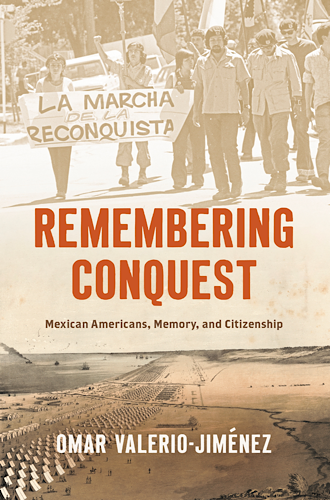With the 1848 Treaty of Guadalupe Hidalgo that ended the US-Mexico War, Mexican Americans became the first non-white population to become US citizens. University of Texas at San Antonio historian Omar Valerio-Jiménez reminds us that most Mexican American never enjoyed full citizenship rights. In Remembering Conquest: Mexican Americans, Memory and Citizenship, Valerio-Jiménez reveals how Mexican Americans lost their land and political influence and were subjected to lynching and unequal treatment by the legal system. It was the failed promise of the Treaty of Guadalupe Hidalgo that inspired generations of Mexican Americans to struggle for full citizenship rights.
How the first generation of Mexican Americans who lived through the US-Mexico war experienced this second class status depended on a variety of factors. For example, some elites, like María Amparo Ruiz de Burton, from a wealthy, landed family of Californios, were able to marry Euro-Americans. Ruiz de Burton married Henry Burton, a lieutenant in the US Army and graduate of West Point. Ruiz de Burton would go on to become the first Mexican American novelist. However, her second novel, The Squatter and the Don (~1890s) offers a semi-fictional account of her own family’s story of dispossession following the conclusion of the US-Mexico War. Victims of squatters and a costly legal process to authenticate the title to their land, Ruiz de Burton depicts the destitution of a wealthy Californio family that mirrors her own family’s story.
Beyond fictional accounts, Spanish language newspapers functioned as a powerful mechanism across several generations for speaking out against the injustices experienced by Mexican Americans. This was the case with Francisco Ramírez who at the age of eighteen founded the Los Angeles based newspaper El Clamor Público. The multilingual Ramírez was originally a believer in the possibility of assimilating into the new Euro-American culture but quickly became disenchanted by all that he saw around him. While Ramírez decried the dispossession of Mexican Americans following the war, he took a greater interest in the violence experienced by Mexican Americans. He labeled the United States a “linchocracia” or lychocracy to denounce the violence experienced by Mexican Americans who were expelled from work in the mines following the California gold rush and subjected to vigilante justice.
A less common reaction to the injustices following the US-Mexico War was rebellion. Perhaps the largest and most notable case was the Cortinista Rebellion (1859-1860) in Texas. On the surface the family of Juan Cortina seemed to be managing the transition from Mexico to the United States with little difficulty. His older brother prospered in business before winning races for local elected offices. His younger brother became a tax collector. But beneath this veneer of success the Cortinas suffered the same experience of dispossession as that of Ruiz de Burton’s family in California. After coming to the rescue of a Tejano worker being pistol whipped by a Brownsville marshal, Cortina fled across the border only to return as a leader of a six hundred strong rebellion. The Cortinistas, as they become known, took control of the city of Brownsville, murdered several Euro-American Texans known for their mistreatment of Mexican Americans, and freed prisoners who had been victims of a justice system that disportionately convicted and incarcerated Mexican Americans. Many of the complaints and aspirations of this six month rebellion were left for posterity in written statements known as the proclamations. The chief cause of the injustices experienced by Mexican Americans highlighted in the proclamations was the failure to enforce the Treaty of Guadalupe Hidalgo.
By the 1880s, thirty years after the war, transnational sources of memory were instrumental in educating later generations about the US-Mexico War and its aftermath. In addition to immigrants who carried Mexico’s official memories across the border, reports from Mexican newspapers could be recirculated and recycled in Spanish language newspapers in the United States. This was certainly the case with the Santa Barbara newspaper La Gaceta. In 1881, the Gaceta published an article encapsulating the outbreak of the war with descriptions of key battles. The article, which reminded readers that California had once been part of Mexico and clearly assigned blame to the United States for the invasion, drew primarily from a Mexican newspaper article published thirty years earlier.
As growing numbers of Mexicans left for the United States starting with the dictatorship of Porfirio Díaz (1884-1911) and especially during the Mexican Revolution (1910-1920), Mexican Americans responded by taking different positions toward the past. Affluent and professionally accomplished Mexican Americans who formed the League of United Latin American Citizens or LULAC in 1929, embraced the status of whiteness and the promise of full citizenship offered by the Treaty of Guadalupe Hidalgo. If that promise had never been kept, many LULAC members believed that it was because European Americans were not fully informed about the myriad ways that Mexican Americans had fought for and contributed to the United States. The initial impetus to preserve and memorialize the Alamo, long a source of distrust and hostility toward Mexicans and Mexican Americans, was to spotlight how Tejanos also fought and died to create the Republic of Texas. Similarly, supporters of LULAC wrote histories that featured the contributions of Mexican American to the United States not just during the US-Mexico War, but during the First and Second World Wars. Convinced that education was the answer, some even retroactively reimagined the period prior to the US-Mexico as one of forgotten harmonious relations between Mexicans and Euro-Americans which could be restored in the future.
If LULAC was made up of professionals who tried to accommodate Euro-American culture, the Asociacíon National México-Americano (ANMA), started in 1949 as a more radical miners’ union. Whereas LULAC closed its membership to immigrants fearful their lack of acculturation would impede the acceptance and inclusion of Mexican American citizens, ANMA remained open. Whereas LULAC stressed Mexican American roots in a European Spanish colonial past, ANAMA spotlighted the forced inclusion of Mexican Americans through invasion and rejected the celebration of whiteness. ANAMA denounced the failure of the United States to respect and proprotect the language, culture and property of Mexican Americans as promised by the Treaty of Guadalupe Hidalgo. Rather than celebrating a fictional past of harmonious relations between Mexicans and Americans, ANMA traced the second class status of Mexican Americans directly to the US-Mexico War.
The milititanism of ANMA carried over into the 1960s and 1970s to organizations like La Alianza Federal de la Mercedes and the Brown Berets. La Alianza (Federal Land Grant Alliance) was founded in the early 1960s by Reies López Tijerina. Son of a poor migrant couple from Texas whose family had experienced a long history of racially motivated violence, injustice, and wage theft, Tijerina helped energize the preexisting land grant movement. Appealing to African, Native American and European Americans alike, La Alianza sought to promote awareness of the theft of formerly Mexican owned land following the US-Mexico War.
While many people in the United States have forgotten the US-Mexico War, the conflict remains singularly important for Mexican Americans, as it led to their physical separation from the Mexican nation as well as their loss of social, economic, and political status. The treaty ending the war also provided Mexican Americans with US citizenship, but the treaty’s promises were never fully enforced by the United States. Nevertheless, the treaty remains significant for the civil rights objective of Mexican Americans. Remembering Conquest: Mexican Americans, Memory and Citizenship, Omar Valerio-Jiménez.
The radical strategy that helped La Alianza gain national prominence and a leadership role with the Chicano Rights Movement was the occupation of land grants on federal and private property. Eight members of the Alianza, for example, were charged with unlawful assembly and jailed after occupying the San Joaquín del Río de Chama land grant in New Mexico in 1967. Alianza members responded by attacking the courthouse, shooting and injuring two law enforcement officers and taking two hostages. The raid was enthusiastically supported by members of the Chicano movement who called for more aggressive actions. Other publicity generating initiatives included an attempted citizens’ arrest of Chief Justice Earl Warren “for committing crimes against the people.”
The Brown Berets originated in the Los Angeles area in the 1960s. With khaki colored military style uniforms and brown berets, they targeted high school students for recruitment, denounced police harassment and called out for better schools. They called on the government to respect and enforce the US Constitution and the Treaty of Guadalupe Hidalgo. To promote awareness of problems affecting the Latino community they organized La Marcha de la Reconquista in 1971 (March of the Reconquest). Rather than asserting a desire to reconquer the land, the title of the march proclaimed an awareness of the rights and history of Mexican Americans and their ability to effect change. In their three month, 800 mile march from the US-Mexico border town of Calexico to Sacramento, they sought to promote awareness of police brutality, the struggle of farm workers, claims to land, ethnic pride and opposition to the policies of the then California governor Ronald Reagan.
Following up on the success of La Marcha, the Brown Berets organized La Caravana de la Reconquista (Caravan of the Reconquest). Starting in Southern California in the fall of 1971, the Caravan traversed the states of Arizona, New Mexico, Colorado and Texas with a brief trip to the Midwest. In the course of the twelve month trip, the participants learned about the issues and histories of the communities they encountered along the way. In Tuscan, Arizona, for example, they discovered and joined forces with efforts by a Chicano community to transform part of a municipal golf course into a public park which they hoped to name after Joaqúin Murrieta, a nineteenth “bandit” sometimes known as the “Robinhood of the West.” In Tuscan, as they did elsewhere, the Brown Berets created monuments to figures like Murrieta or Juan Cortina to recall past struggles and their continuities in the present.
As fears about the border reach fever pitch, Omar Valerio-Jiménez reminds us not to forget how the border was created and its consequences for Mexican Americans. His work shines a much needed light on the injustices experienced by Mexican Americans who were offered but never received full citizenship rights. While the diversity of experiences across time, place, class, and gender negate the possibility of a shared collective memory, the unfulfilled promise of the Treaty of Guadalupe Hidalgo has been a common thread and reference point that has inspired generations of Mexican Americans to fight for change.
Awareness of past experiences of victimization, however, does not necessarily lend itself to much introspection about the role of Mexicans and their Spanish forebearers as perpetrators. As is the case with many other peoples, Mexicans have experienced the past both as perpetrators and victims. They have suffered the trauma and the injustices of conquest and they have inflicted similar traumas and injustices on Native Americans. Just as the memories of past experiences of victimization stretch across generations, so does the forgetting of past crimes perpetrated by Spanish colonizers and their Mexican successors. A true reckoning requires a sincere and honest confrontation with the past, warts and all.

Omar Valerio-Jiménez
Omar Valerio-Jiménez is a professor of history at the University of Texas at San Antonio. He is the author of River of Hope: Forging Identity and Nation in the Rio Grande Borderlands (2013) and Remembering Conquest: Mexican American, Memory and Citizenship (2024).

